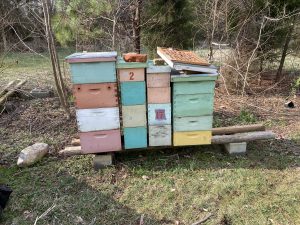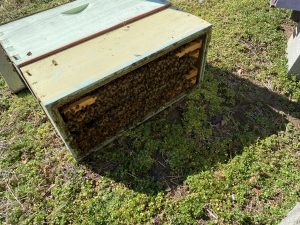The first Beekeeping task of the year is behind me. Typically (or hopefully!), in early February, I will look for a day that rises into the 50’s and go to all of my outyards, looking for deadouts. 95% of these hives will have perished after the first frost and have pristine, drawn wax and maybe even some honey stores. I like to get these right off, as they have a big impact on my next couple of tasks in the beeyards.
What causes these deadouts? Many folks reach out to me when they have a dead hive and ask “why do you think my bees died?” I understand that curiosity, but for me it is simply part of the numbers game. I am going to lose some hives – a few will have starved out, most simply swarmed late in the season and didn’t build up a big enough cluster to survive and (I believe) some had weak queens or one of the bee parasites/diseases troubling them. I pretty much take the position that most of these bees had weak genetics and Winter culls them from my heard. It’s a good thing!
Another thing that many folks seem concerned about is using frames or equipment from deadouts. There were some foulbrood problems before I got into beekeeping that could carry over from hive to hive, but I have not experienced any problem with reusing frames and equipment. I have been doing it for years and my bees continue to get healthier.

It should be noted that this initial run only identifies hives with ZERO bees. I only take off the outer cover and look for bees. If I see honey bees, I leave the hive alone, although I do lift the back of the hive up to take a weight measurement. My point here is that I know I still have hives that are in trouble (you can only assess that by taking them fully apart and digging into the brood next.) But, at this stage, it appears that I lost 6 hives or overwintered Nucs, moving my total colony count to 27. I had 3 light hives (by that, I mean that they seemed light when I tilted them forward by picking them up from the back) and several (heavy) hives with honey supers still on them. All in all, I am happy with the results, compared to what I expected. This is on the high end of my normal Winter losses, but I happen to know that 2 (overwintered nucs) were dice rolls last Fall (they were weak and I decided not to combine them, just to see how they would fare.)

Another interesting event occurred with a nuc falling over! I happened to get a call from a lady that the previous day’s storm (insanely strong winds) had knocked over one of my hives. I found them with lots of bees and very good honey stores. They have been set aright now and I am fairly confident they will move on to a full size hive (unless the queen actually was damaged in this tumble.) More on this hive later!!!!
